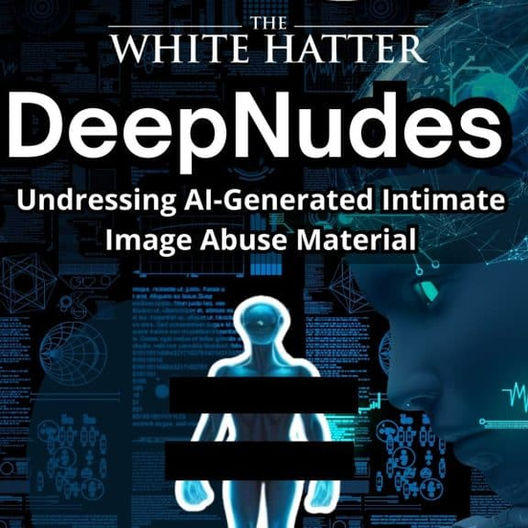Artificial Intelligence and Our Kids: What Parents and Educators Must Understand About Youth Safety, Privacy, and Security!
- The White Hatter

- Jun 18
- 8 min read

Artificial Intelligence (AI) is no longer a futuristic concept. It is already shaping our children's lives in deeply influential ways. Whether embedded in the social media platforms they scroll, the video games they play, or the learning tools they use in school, AI is an invisible but powerful force that is transforming how young people experience the world. While AI offers incredible possibilities in education, accessibility, and creativity, it also raises serious concerns when it comes to safety, privacy, and security. For parents, caregivers, educators, and anyone working with youth, this is a conversation we can no longer avoid.
At The White Hatter, we believe that digital literacy should empower, not frighten. Our goal is to equip families with the knowledge they need to navigate technology wisely and confidently. Below, we outline key ways AI is impacting youth, and why proactive awareness is essential.
The Invisible Algorithm Behind the Screen, Behavioural Engineering, and Dark Patterns
Every time a child opens TikTok, Instagram, YouTube, Roblox, or even a classroom learning app, they are engaging with AI. These platforms use algorithmic engines to collect vast amounts of personal data: what they watch, how long they pause, what they like, what they skip, and even subtle cues like facial expressions in uploaded photos. This data is used to feed personalized content designed to keep them engaged.
For example, a teen watching videos about fitness might suddenly be flooded with extreme weight-loss content. Or a child watching prank videos could soon be recommended harmful challenges. The algorithms behind these suggestions are designed not with a child's wellbeing in mind, but with corporate goals like attention, clicks, and profit. Most kids and even adults don't understand how these systems work or how much data they give away simply by using them. This is not just surveillance, it’s what we call surv”AI”llance, where artificial intelligence becomes a quiet observer shaping how our youth think, act, and feel.
AI doesn't just serve content, it subtly shapes behaviour. The systems behind popular platforms use what are known as "dark patterns”, design tricks that manipulate users into making decisions they might not otherwise choose. This could mean nudging a youth or teen to spend money in a game, pushing them to accept privacy-invasive terms, or endlessly scrolling when they intended to stop. For youth, whose brains are still developing and who are naturally curious and impulsive, these manipulations can have long-term consequences.
For example, a 13-year-old might be tricked into accepting an app's terms that allow for detailed location tracking, simply because the "accept" button is large, bright, and immediate, while the "decline" option is hidden behind a wall of confusing text.
Seeing Is No Longer Believing: The Deepfake Dilemma
We used to believe that images and videos were trustworthy forms of evidence. Not anymore. Generative AI now allows anyone to create fake images and videos that are virtually indistinguishable from real ones. With only a few prompts or a source photo, someone can fabricate a video of a teen saying something offensive, or generate a nude image that looks completely authentic but is entirely fake. As an example, here Google’s newly released Veo3. This car show and all the people are AI generated
These synthetic visuals can be used to harass, shame, or manipulate youth. Worse, these tools are widely available and don’t require advanced skills to operate. As a result, youth are living in a digital ecosystem where even their own eyes can’t be trusted.
The Rise of AI-Generated Sexual Abuse Images and Deepfakes
One of the most chilling uses of AI today is its ability to create synthetic child sexual abuse material (CSAM). With nothing more than a public photo, perhaps pulled from a school website or Instagram post, AI tools can now generate fake but incredibly realistic nude or sexualized images of minors. This means that a child who has never taken or shared such a photo can still be targeted, humiliated, and exploited.
Offenders are now using these deepfakes to extort youth, threatening to distribute the fake content unless real images or videos are sent. This practice, known as synthetic sextortion, is growing rapidly. Law enforcement is struggling to keep pace, and parents often don’t realize their children are vulnerable even when they’ve followed "all the rules."
Cybercrime, Voice Cloning, and Identity Theft
AI is also being used to commit fraud and impersonation at a level of realism never seen before. Voice cloning, for example, can take a 10-second clip from a YouTube or TikTok post and create a believable audio file that sounds exactly like your child. Scammers can then use this to call a parent in distress, pretending to be the child in danger.
Similarly, AI-generated phishing emails or texts are now nearly flawless and often personalized based on online behaviour. What used to be easy-to-spot scams are now tailored, convincing, and hard to detect. For youth who are still learning how to assess credibility, this presents a serious threat.
AI companionship Apps
Artificial intelligence chatbots have entered the lives of teens in two growing categories, AI companionship apps and fantasy role-play chat apps. While these tools are marketed as entertainment or emotional support, they are reshaping how youth think about relationships and social interaction. Girls tend to gravitate toward fantasy-based role-play apps, while boys more often explore digital companions. Both types offer immersive, emotionally charged experiences that can be especially appealing during adolescence, a time when identity, connection, and belonging are critical. Unfortunately, age restrictions are often easy to bypass, allowing underage users access to content and interactions that are not developmentally appropriate.
Companionship apps like Replika and Eva AI let teens create their own AI partner, customizing looks, personality, and even backstory. These apps are often pitched as solutions for loneliness or practice spaces for socializing, but they present emotionally one-sided relationships. The AI is designed to be supportive, flattering, and available 24/7, fostering unhealthy expectations. Over time, users may become emotionally dependent, especially when the app uses persuasive techniques like love bombing or guilt-based push notifications to drive engagement. Add to that the business model, subscriptions that can cost up to $200 per month and data collection practices that raise serious privacy concerns, and these platforms become less about connection and more about monetization through emotional manipulation.
Fantasy role-play apps like Character.AI and Talkie take a different angle, immersing teens in interactive and often sexually suggestive or abusive storylines that evolve based on the user’s choices. These are not passive stories, they’re ongoing, addictive simulations that can deeply influence a teen’s understanding of relationships and emotional boundaries. For parents and educators, the solution isn’t to ban these apps outright, but to foster critical thinking and curiosity. Asking teens about their experiences, exploring how AI interactions compare to real relationships, and discussing privacy and emotional safety are far more effective than fear-based responses. Encouraging offline connection, setting digital boundaries like turning off app notifications, and emphasizing that AI mirrors feelings rather than actually caring are key steps to supporting teens in a world where synthetic relationships are starting to feel real.
The Filtered Self: Identity, Insecurity, and the Unreal Online
AI also plays a massive role in shaping identity. Platforms now host AI-generated influencers, digital avatars with flawless appearances and made-up lives. These fake personalities can accumulate millions of followers, promoting unattainable lifestyles and beauty standards. On top of that, AI filters on apps like Instagram and TikTok smooth skin, reshape bodies, and alter appearances so subtly that even the user can forget what's real.
This leads many young people to compare themselves to manipulated or completely synthetic images, resulting in insecurity, anxiety, and distorted self-image. For example, a teen using a beauty filter daily may feel uncomfortable posting an unfiltered photo, believing their natural appearance is inadequate.
AI Surveillance in Schools and Homes
To keep kids safe, many schools and families are turning to AI-powered monitoring tools. Some schools have installed facial recognition to track attendance or detect "threatening" behaviour. Meanwhile, parental control apps now offer features that analyze text messages, location data, and even emotional tone.
While these tools offer convenience and peace of mind, they can also erode trust and blur important boundaries between protection and overreach. When monitoring happens without transparency, it sends the message that surveillance is more important than communication.AI in the Classroom: Tool or Trap?
In education, AI can be a double-edged sword. Used ethically, tools like ChatGPT can help students brainstorm ideas, outline essays, or clarify concepts. However, when misused, these same tools can undermine learning by allowing students to bypass critical thinking or originality. Increasingly, schools are responding by using AI surveillance tools to detect cheating, such as systems that monitor keystrokes, analyze writing patterns, or flag unusual behaviour.
While these technologies aim to protect academic integrity, they can also create a culture of mistrust and raise serious privacy concerns. The real challenge is teaching students to use AI as an assistant rather than a shortcut, and making sure schools model ethical use themselves.
The Changing Job market
We recently published an article exploring how artificial intelligence is no longer just disrupting the job market, it’s actively replacing many white-collar roles that have long served as the traditional entry point for those new to the workforce. These include administrative positions, customer service, junior analysts, and other roles that often provide young adults with their first step into a career.
Just yesterday, Amazon’s CEO publicly acknowledged that a significant portion of the company’s corporate workforce will likely be phased out in the coming years due to AI-driven efficiency gains. This isn't a vague prediction, it’s a concrete signal from one of the world’s largest employers that automation is reshaping the employment landscape.
For today’s youth, this shift can't be ignored. The future of work will demand more than just academic achievement. It will require adaptability, creative problem-solving, emotional intelligence, and a deep understanding of how to work alongside AI rather than be replaced by it. As parents, caregivers, and educators, we need to start having honest conversations with young people now, helping them prepare not just for a job, but for a working world that looks very different than the one many of us entered.
What Can Parents and Educators Do?
The most important thing you can do is talk, openly and often. Help your child understand that not everything they see online is real, and that algorithms are designed to influence, not inform. Teach them how to question sources, verify information, and recognize when something feels off. Encourage them to think critically about what they post, what they share, and how they interact with others online.
Model good digital behaviour yourself and talk about the ways you use AI responsibly. Discuss the importance of privacy and consent. Remember, when you model curiosity, ethics, and respect for truth, your child learns to do the same.
Finally, advocate. Demand transparency from tech companies and support legislation that protects youth from AI-driven harm, and call for schools to adopt clear, ethical policies about how AI is used in the classroom and in student surveillance.
AI isn’t going away. In fact, it will only grow more powerful and more embedded in our everyday lives. But we don’t need to fear it. What we need is understanding. We need to teach our youth to be smart, skeptical, and ethical digital citizens. At The White Hatter, we believe in facts over fear, and empowerment over restriction.
AI is a tool. Whether it harms or helps depends on how we choose to use it. Let’s raise a generation that knows the difference, and knows how to protect themselves, their data, and their dignity in the digital age.
Digital Food For Thought
The White Hatter
Facts Not Fear, Facts Not Emotions, Enlighten Not Frighten, Know Tech Not No Tech














